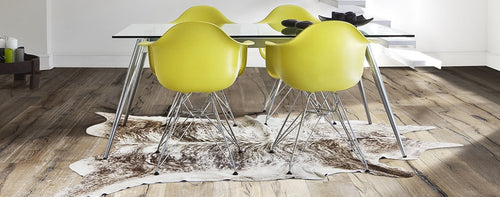Installing your flooring on a staircase is a very similar process whether you're using solid, engineered or laminate flooring. We recommend against using LVT floors on the stairs because some of the designs don't have enough friction.
- Preparing the surfaces:Firstly, remove any cladding you currently have on the stairs. The process will be different depending on what floor you have installed, but be sure to remove all flooring materials, nails and staples from the staircase. Then, sand down the surfaces so that they're level and ready for adhesive. Be sure to sweep and clean the stairs before you start recladding them - it will make the whole process a lot easier!
- The Risers:Take a measurement for the risers (the vertical piece which goes on the front of the stairs). Some staircases can be uneven, so it's worth taking a measurement for all four sides. Now, cut your flooring to size, letting the panel cover the whole of the area. Apply adhesive in an S pattern across the board and press the riser into place, holding it firmly for a few moments until it can support itself (it will take more time to properly set so remember to be careful with it until then).
- The Treads:Now, measure the tread (the horizontal piece which goes on the top of the stairs). As with the riser, be sure to take into account fluctuating dimensions on different sides of the stairs. Once you have your measurements, you'll need to take a little of the end to fit the nosing on - the exact distance will depend on the kind of nosing you're using. If you're laying engineered or solid wood flooring, you can now glue down the tread using an S-shaped pattern of adhesive.
- The Nosing:For laminate floors you'll need to install a nose base before you lay the tread, but for solid and engineered, the stair nosing should fit over the top, keeping its place with the locking mechanism. Whatever style you opt for, remember to double check all the measurements before you cut to make sure that everything will fit together nicely. Once you're ready, apply adhesive along the nosing and fit into place.
Below are links to some videos which may help with your installation:


